You invested your hard-earned money into your mode of transportation, and therefore, you want to take care of it as best you can. You don’t need to clutter your home with expensive cleaning chemicals that are harmful to your health and damaging to your car’s interior while trying to keep it clean. Instead, you can use some common household products.
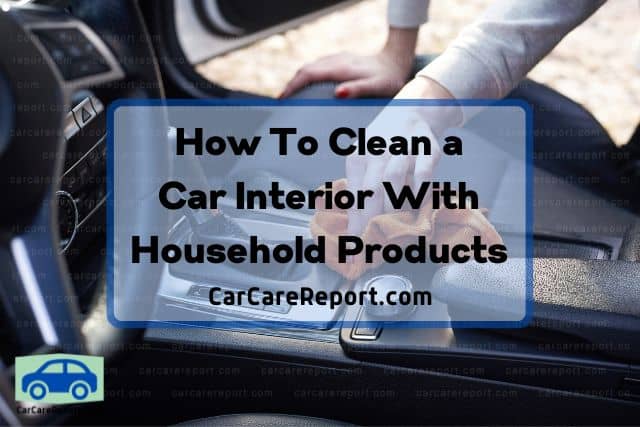
Here are best practices for cleaning your car interior with household products:
- Mix water and vinegar to use as a disinfectant
- Use dryer sheets and rubbing alcohol for hard surfaces
- Mix vinegar and linseed oil for leather
- Absorb grease stains with cornstarch
- Scrub white leather with non-gel toothpaste
- Rub screens with a microfiber cloth and distilled water
- Remove fabric stains with baking soda and vinegar
These everyday household items are excellent for cleaning your car interior and act as natural germ eliminators, air fresheners, and leather-safe polishers. Continue below to see how you can use everyday items found under your sink to clean your car’s interior.
1. Mix Water and Vinegar to Use as a Disinfectant
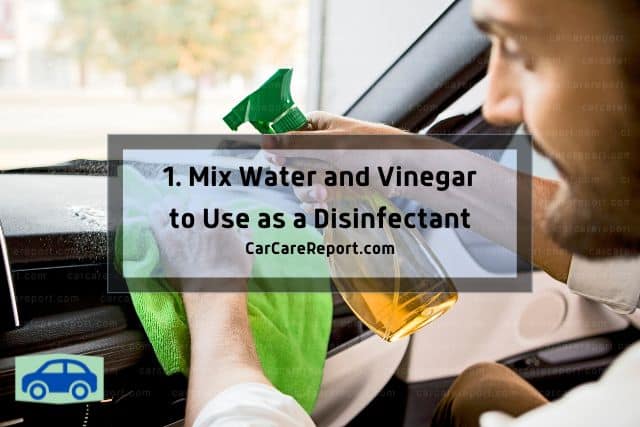
One of the most versatile cleaners you have at your disposal is white vinegar. White vinegar has disinfectant properties that eliminate germs to clean and sanitize surfaces. Not only will white vinegar kill germs, but it also hinders them from coming back.
The David Suzuki Foundation, an organization that advocates for safe and sustainable living, suggests looking for a white vinegar with a 7-12 percent concentration of acetic acid. Most grocery stores will carry a 5 percent concentration, which is fine, but the increase of acetic acid will improve the disinfecting power.
To make a vinegar disinfectant for your car’s interior:
- Mix 1 part distilled water and 1 part white vinegar.
- Once mixed, pour into a spray bottle.
- Spray the mixture onto a microfiber cloth and test on a small, unnoticeable area of your car’s interior. If there are no adverse reactions, use the material to wipe down the surfaces of the interior.
Never use undiluted vinegar by itself due to its highly acidic concentration. This statement may seem contradictory since I just told you to buy higher acetic acid content vinegar. You want to keep the cleaning and disinfecting properties of vinegar without causing damage to your vehicle’s interior.
Always dilute the vinegar with water to avoid discoloration of your fabric. Also, avoid using vinegar directly on any rubber surfaces. The vinegar will dry out the rubber and leave it cracked. If the rubber is a seal, cracking and degrading will not allow the piece to seal correctly.
2. Use Dryer Sheets and Rubbing Alcohol For Hard Surfaces
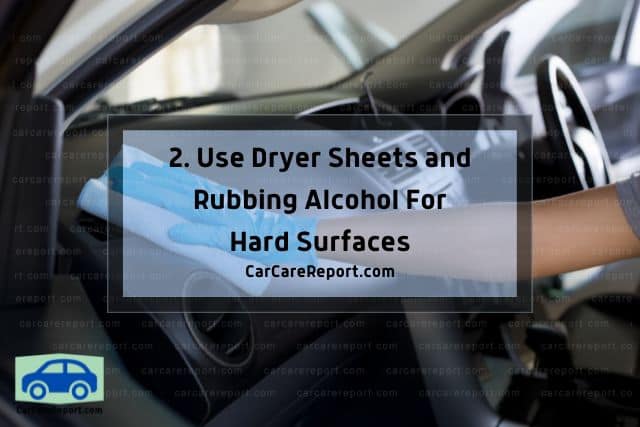
A few hard surfaces in your vehicle will need extra attention. It could be a surface that is touched more often or is prone to spills and messes.
Rubbing alcohol kills 99.9% of germs in less than 30 seconds. If using 100% isopropyl alcohol, dilute the solution with water in a 1:1 ratio in a spray bottle. The water allows the alcohol to remain on the surface longer without evaporating quickly to kill germs more effectively.
Once you spray the alcohol and water onto the surface, allow it to sit for a few seconds to a minute, then wipe with a used fabric softener.
The fabric softener sheet will not leave lint as opposed to other fabrics. New or used fabric softener sheets are also much softer than paper towels or cotton, so they will not scratch surfaces like alternatives might.
3. Mix Vinegar and Linseed Oil for Leather

Leather interior requires special care. You do not want to use harsh chemicals that may degrade or stain the leather. Do not forget to always test any cleaning product on a small, unseen area of the leather before using it on the entire piece in case the mixture causes damage.
To make a leather-safe disinfectant with a polished finish:
- Mix vinegar and linseed oil in a 1:1 ratio.
- Apply a small amount to a microfiber cloth.
- Clean the leather with the mixture in small concentric circles.
- Wipe down any excess oil or liquid.
You risk drying out the leather interior with the vinegar used on its own due to its high acidity. The linseed oil helps to shine, moisturize, and soften the leather, keeping it looking and feeling new.
4. Absorb Grease Stains with Cornstarch

I know I am guilty of eating in my vehicle while on the go. Cornstarch is an excellent absorbent if you have grease stains from leftover fast food sitting on the fabric seats too long, or you have recently worked with grease and forgot to wash your hands or clothes.
Here’s how to use cornstarch to clean your fabric seats:
- Sprinkle the cornstarch heavily on the stain and leave it to sit for 30 minutes.
- Vacuum the powder and reapply if needed.
- Make a paste of cornstarch and water (you want the paste to be thick, if it is too watery, it will absorb into your seat cushions).
- Apply the paste and allow it to dry.
- Brush and vacuum away the dried cornstarch bits.
This cornstarch hack is excellent for fabric seats and fabric-lined floorboards. Due to its absorbent qualities, the cornstarch will also trap and pull seeped-in odors out of the fabric.
5. Scrub White Leather with Non-Gel Toothpaste

The white leather interior is hard enough to keep clean. The last thing you want to do is stain the leather while disinfecting or polishing it. Toothpaste is safe to use on leather interiors once you have tested it on the unnoticeable part of the seat.
Popular home improvement network, a non-gel toothpaste and a soft-bristled brush to remove stains and scuffs from white and light-colored leather.
CarCareReport dot com is owner of this article and was first posted on Sep 20, 2022 and was updated on ..
Apply the toothpaste directly to the stained area and scrub in small, concentric circles with the soft-bristled brush until the stain has lifted. Use a damp microfiber cloth to clear away the toothpaste from the leather, and use a dry cloth to remove any excess moisture.
You can use linseed oil or a leather conditioner to restore and polish the leather.
6. Rub Screens with a Microfiber Cloth and Distilled Water
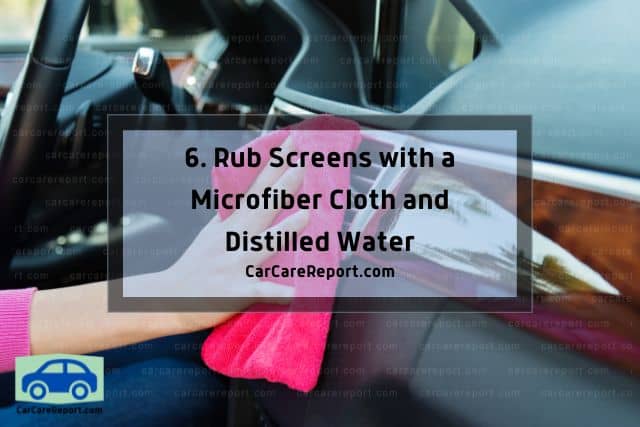
One of the most underrated cleaners is plain distilled water. Unlike tap water, distilled water is free from minerals, and filaments found coming out of the faucet.
Many modern cars come equipped with touch screens and backup cameras that are frequently smudged and hold onto dust. While plenty of screen cleaning products are available in the store and on the internet, the best way to clean a dirty screen is with distilled water and a microfiber cloth.
Even mild disinfectants like vinegar or household germ killers like rubbing alcohol could interfere with the screen. If you have a touch screen in your vehicle, vinegar or rubbing alcohol could reduce the sensitivity or throw off the calibration rendering it useless or difficult to use.
Instead, opt for the distilled water in a spritz bottle. Apply the water to the microfiber cloth and wipe the screen. Microfiber cloths are the best option to avoid scratching the screen because it is soft and does not generally leave lint particles. Finally, dry with a microfiber cloth.
7. Remove Fabric Stains with Baking Soda and Vinegar
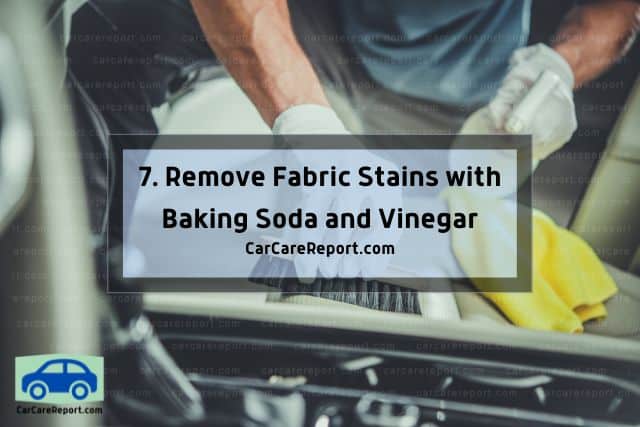
Do you remember the old commercials for Arm & Hammer baking soda? The ones where the woman puts a box of baking soda in the refrigerator to keep the foul smells at bay? I do, and I have used that trick more times than I can count. I use it on fabric upholstered furniture, carpeting, and clothing.
Baking soda is an excellent absorbent and lifts stains and odors almost like magic. With it being such a good overall product, it makes sense that baking soda works well on your car’s interior.
Try this vinegar and baking soda mixture for stubborn fabric stains:
- Spray distilled white vinegar, diluted with water, on the stain.
- Mix vinegar and baking soda into a paste and apply directly to the stain.
- Allow the mixture to sit for approximately 30 minutes.
- Wipe away the mixture with a clean, dry towel.
- Use distilled water to remove any excess mixture, but do not saturate the fabric.
Additionally, baking soda will get in between the cracks and crevices challenging to reach with a cleaning wipe. Sprinkle baking soda in the cup holder, ashtray, and seats, and leave to sit for 30 minutes. You can vacuum the powder, and the smells will disappear with the baking soda.
First published on Sep 20, 2022 by CarCareReport.com.
Add essential oils to the baking soda before sprinkling it in your vehicle for a natural air freshener. This addition will leave a pleasant scent of your creation.
Products To Avoid
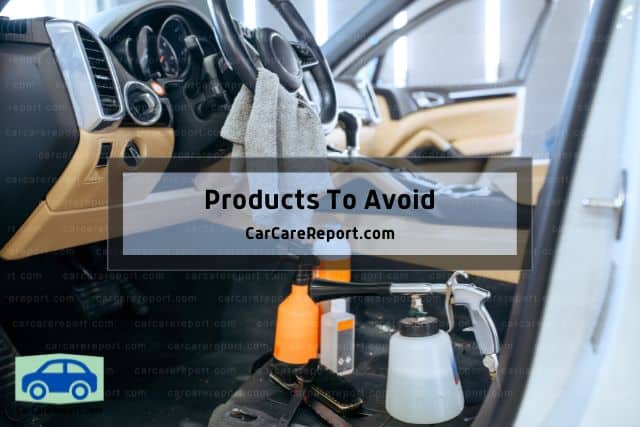
There are household products that work well when cleaning a car’s interior, and then there are household products that you should avoid at all costs.
Some of these everyday items can damage your vehicle or your health. Using these products ranges from mild inconveniences to deadly, toxic fumes. Avoid costly repair bills or the need to seek medical treatment by choosing alternatives to the following items.
Dish Soap
Some resources state that Dawn Dish Soap’s specific brand is safe to use on fabric seats when mixed with five parts of water. However, other resources say that dish soap generally damages your car’s waterproofing.
Dish soap can be an excellent cleanser for the kitchen and bathroom, but that does not mean it is suitable for all surfaces. I would avoid using dish soap as a cleanser or disinfectant on your car’s interior when other household products are safer and more effective for your vehicle. Save the dish soap for the dishes this time.
Paper Towels
Paper towels are not generally harmful, but they are rougher than microfiber cloths. Using a paper towel to wipe a seat can leave lint remnants.
Avoid using paper towels on screens. Since paper towels have a rougher surface for scrubbing, they can scratch the screen. Instead, use a microfiber cloth as directed above.
Bleach
I avoid using bleach whenever possible, especially in my vehicle. Bleach can be harmful to you in a confined space, even when diluted. Side effects from using bleach in a small area, like in your vehicle, include eye or skin irritation, difficulty breathing, and gastrointestinal distress.
Aside from its dangers to you and your family, bleach often reacts with fabric colors and turns dark spots white or yellow. When you are trying to remove stains, you do not want to remove or damage the color of the underlying fabric.
If you absolutely must use bleach, always dilute the chemical with water. Use one part bleach and ten parts water for a 1:10 ratio. Only use bleach in a well-ventilated area, so your best option while cleaning your vehicle is to roll the windows down or keep the doors open. Turn the vents on as well for improved airflow.
Ammonia
Ammonia has similar effects as bleach, and you should not use it in small, confined spaces. Skin and eye irritation and difficulty breathing are common when using ammonia.
Never use ammonia and bleach together as it creates a deadly, toxic mixture known as mustard gas. Phosgene gas (mustard gas) attacks and kills tissue through inhalation, making it incredibly dangerous in large spaces and deadly in small areas like a vehicle.
Specifically relating to your car, ammonia can also ruin your tinted windows. Ammonia is caustic and will cause the window tinting to peel and chip away. Stick with a tinted window-safe cleaner or clean with distilled water and a microfiber cloth.
Final Thoughts
You can clean your vehicle’s interior with household products from under your sink. Use a vinegar and linseed oil mixture or toothpaste and a soft-bristled brush to remove stains and polish your leather. Water and vinegar are easy DIY disinfectants for multiple car interior surfaces.
Cornstarch and baking soda absorb and remove stains from your car’s fabric to make them look brand new. Add essential oils to the baking soda for a fresh scent. Used dryer sheets and rubbing alcohol also disinfect hard surfaces.
Avoid dish soap, paper towels, bleach, and ammonia when cleaning your car’s interior.
Related Articles
How To Hand Wash a Car Faster (Tips and Tricks)
How To Detail a Car That Has Ceramic Coating
Shampoo vs. Steam Clean: Which is Better for a Car?
How To Use a Rubbing Compound on Clear Coat
CarCareReport dot com first published this article on Sep 20, 2022..
